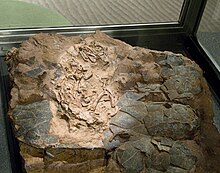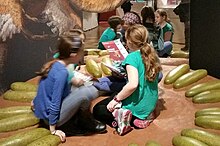Macroelongatoolithus
| Macroelongatoolithus Temporal range:
| |
|---|---|

| |
| Specimen dubbed "Baby Louie", preserving a Beibeilong hatchling with Macroelongatoolithus eggs | |
| Egg fossil classification | |
| Basic shell type: | Ornithoid |
| Morphotype: | Ornithoid-ratite |
| Oofamily: | †Elongatoolithidae |
| Oogenus: | †Macroelongatoolithus Li et al., 1995 |
| Synonyms | |
|
Oogenus synonymy | |
Macroelongatoolithus is an oogenus of large, fossil theropod eggs (probably representing a giant oviraptorid). They are known from Asia and from North America.[1][2]
Distribution
Fossil Macroelongatoolithus eggs have been found in the United States, China, and South Korea, ranging in age from Early Cretaceous to Maastrichtian.[2] More specifically, it is known in North America from the Cedar Mountain, Dakota, and Kelvin Formations of Utah,[3] the Wayan Formation of Idaho, the Blackleaf Formation of Montana, the Thomas Fork Formation of Wyoming,[2] and the Willow Tank Formation of Nevada.[4] In China, it is known from the Liangtoutang and Chichengshan Formations in Tiantai County, Zhejiang Province,[5][6] from the Gaogou, Sigou, Majiacun, and Zoumagang Formations in Henan Province, China.[2][7][8] It is known in South Korea solely from the Goseong Formation near Tongyeong.[9]
Description

Macrooelongatoolithus eggs are most notable for their large size. They are at least 34 centimetres (13 in) long by 11 centimetres (4.3 in), but the largest specimens are over 60 centimetres (24 in) long.[2] They are also very elongated, usually roughly three times longer than they are wide. They are often found in large clutches of up to 26 eggs, with the eggs forming a ring 2–3.3 metres (6.6–10.8 ft) in diameter. The shell is typically between 1.38 mm and 4.75 mm thick.[2][3]
Like other elongatoolithids, Macroelongatoolithus's eggshell is divided up into two structural layers, and the outer layer (called the continuous layer) is not divided up into distinct shell units, unlike other oofamilies. In Macroelongatoolithus, the boundary between the continuous layer and the mammillary layer (the inner layer of the eggshell, also called the cone layer) is wavy, but clearly defined. The ratio of the thickness of the two layers varies from 2:1 to 8:1.[2]
The surface ornamentation of the eggshells is variable, even on a single egg. It is usually lineartuberculate (nodes forming linear ridges), ramotuberculate (nodes forming irregular, meandering chains), or dispersituberculate (scattered nodes).[2]
Macroelongatoolithus specimens are extremely variable in size, shape, and microstructure, even in eggs laid by a single individual. For example, within a single clutch, the egg lengths can vary by several centimeters. The high amount of variability is probably due to their large size.[3]
History

Historically, several oospecies have been assigned to Macroelongatoolithus, however they are all now considered to be a single oospecies: M. carlylensis.
"Oolithes" carlylensis was described in 1970 by James Jensen.[10] In 1998, O. carlylensis was moved to a new oogenus, Boletuoolithus, which was then classified as a Spheroolithid.[11] Macroelongatoolithus was first described in 1995 by Li et al., with a single oospecies: M. xixiaensis. It was classified in the oofamily Elongatoolithidae.[12] Later in the same year, Wang and Zhou described Longiteresoolithus xixiaensis, which they placed into a new oofamily, Macroelongatoolithidae. These three oospecies are now considered synonymous, and generally classified in Elongatoolithidae. Since M. carlylensis was named first, it has priority, but the name was corrected to M. carlylei to follow ICZN provisions.[2][3]
Two other oospecies have also been described: M. zhangi and M. goseongensis, but both are now considered synonymous with M. carlylensis.[2] The oogenus and oospecies Megafusoolithus qiaoxiaensis is also a junior synonym of Macroelongatoolithus carlylei.[2]
Paleobiology

While they are occasionally considered to be the eggs of tyrannosaurs (like Tarbosaurus) on the basis of their huge size,[13] most evidence suggests they are eggs of gigantic oviraptorids (like Gigantoraptor).[2] The egg shape and structure closely resembles the eggs of Citipati,[7] and many lines of fossil evidence (including association, embryonic remains, and eggs found within parents) link other elongatoolithids to oviraptorids.[2] Also, a Macroelongatoolithus specimen named "Baby Louie" consisting of four fossil eggs and associated perinatal remains was discovered in the Zoumagang Formation.[14] Characteristics of the jawbone of this specimen resemble oviraptorids.[2]
The presence of Macroelongatoolithus in the United States indicates that there was likely a giant oviraptorid present in Cretaceous North America. Also, the fact that they have been found in both Asia and America is evidence of an Albian-Cenomanian interchange of fauna between the two continents.[2]
The gas conductance of the eggshells indicate that Macroelongatoolithus nests were buried in vegetation or sediments. Like other elongatoolithids, Macroelongatoolithus eggs are laid in pairs because the parents had two functional oviducts and thus laid two eggs simultaneously. The nests have unusually large volume of eggs compared to the body size of the parents, which could mean that multiple females would contribute to a single nest. Association of other oviraptorids with their eggs suggests extensive parental care was typical for elongatoolithids.[2]
Parataxonomy
Macroelongatoolithus has a convoluted parataxonomic history. Several oospecies have been described, but currently they are all considered synonyms of M. carlylei. While it is occasionally classified into a separate oofamily, Macroelongatoolithidae, the general consensus is that it is a member of Elongatoolithidae.[2]
See also
References
- ^ Carpenter, K. 1999. Eggs, Nests, and Baby Dinosaurs: A Look at Dinosaur Reproduction (Life of the Past). Indiana University Press, Bloomington, Indiana.
- ^ a b c d e f g h i j k l m n o p q Simon, D. J. (2014). "Giant Dinosaur (theropod) Eggs of the Oogenus Macroelongatoolithus (Elongatoolithidae) from Southeastern Idaho: Taxonomic, Paleobiogeographic, and Reproductive Implications." (Doctoral dissertation, Montana State University, Bozeman).
- ^ a b c d Zelenitsky DK, Carpenter K, Currie PJ. (2000) "First record of Elongatoolithid theropod eggshell from North America: the Asian oogenus Macroelongatoolithus from the lower Cretaceous of Utah." Journal of Vertebrate Paleontology 20(1): 130-138.
- ^ Bonde, Varricchio and Jackson, Loope, Shirk, Joshua W., Frankie D. and David J., David B., and Aubrey M. (January 2008). "Dinosaurs and dunes! Sedimentology and paleontology of the Mesozoic in the Valley of Fire State Park". The Geological Society of America. 11: 249--262.
{{cite journal}}: CS1 maint: multiple names: authors list (link) - ^ X. Jin, Y. Azuma, F. D. Jackson and D. J. Varricchio. (2007) "Giant dinosaur eggs from the Tiantai basin, Zhejiang province, China." Canadian Journal of Earth Sciences 44:81-88.
- ^ Wang Qiang, Zhao Zikui, Wang Xiaolin, Jiang Yangen, and Zhang Shukang. (2010) "A New Oogenus Of Macroelongatoolithid Eggs From The Upper Cretaceous Chichengshan Formation Of The Tiantai Basin, Zhejiang Province And A Revision Of The Macroelongatoolithids" Acta Paleontologica Sinica 49(1):73-86.
- ^ a b Grellet-Tinner, G., Chiappe, L., Norell, M., and Bottjer, D. (2006). "Dinosaur eggs and nesting behaviors: a paleobiological investigation." Palaeogeography, Palaeoclimatology, Palaeoecology, 232(2): 294-321.
- ^ Li, G., Chen, P., Wang, D., & Batten, D. J. (2009). "The spinicaudatan Tylestheria and biostratigraphic significance for the age of dinosaur eggs in the Upper Cretaceous Majiacun Formation, Xixia Basin, Henan Province, China." Cretaceous Research, 30(2): 477-482.
- ^ Kim, J. Y., Yang, S. Y., Choi, H. I., Seo, S. J., & Kim, K. S. (2011). Dinosaur eggs from the Cretaceous Goseong formation of Tongyeong City, southern coast of Korea. Journal of the Paleontological Society of Korea 27(1): 13-26.
- ^ Jensen J. 1970. Fossil eggs in the lower cretaceous of Utah. Brigham Young University research studies. Geology Series. Geology Studies 17: 51-65.
- ^ Bray, E. S. 1998. Dinosaur eggshell Boletuoolithus carlylensis, oogen. nov. from the Lower Cretaceous Cedar Mountain Formation of Utah; pp. 221–223 in S. G. Lucas, J. I. Kirkland, and J. W. Estep (eds.), Lower and Middle Cretaceous Terrestrial Ecosystems. New Mexico Museum of Natural History and Science Bulletin No. 14.
- ^ Li Y, Yin Z, Liu Y. (1995) "The discovery of a new genus of dinosaur egg from Xixia, Henan, China." Journal of Wuhan Institute of Chemical Technology 17(1): 38-41. (In Chinese)
- ^ Qian, M. P., Jiang, Y., Jiang, Y. G., Zhang, Y. J., Chen, R., Li, L. M., and Xing, G. F. (2008). "New evidence on fossil eggs of Cretaceous Tyrannosaurs in eastern China." Jiangsu Geology, 32: 86-97.
- ^ Grellet-Tinner, G. (2005). A phylogenetic analysis of oological characters: A case study of saurischian dinosaur relationships and avian evolution [dissertation] [Los Angeles (CA)]: University of Southern California. Chicago.
